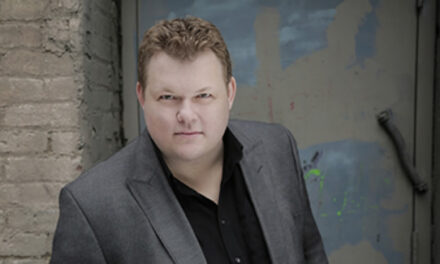Like school kids let out on recess, players from the NCS often go wild musically when they get the chance to perform, freed from their daily constraints. The year’s first Jewel Edgerton Williamson chamber music concert in the Kenan Recital Hall was a wild affair, presenting some of the outré music of the last 50 years or so. Both performers and audience had a blast, which goes to show that you don’t have to play it safe with programming.
The program opened conventionally enough with Deux Rhapsodies for Oboe, Viola and Piano by Charles Martin Loeffler (1861-1935), a German who tried to pass himself off as French and lived most of his adult life in the USA. Oboist Melanie Wilsden, violist David Marschall, both of the NCS and pianist Milton Laufer of Peace College, did their best to put life into the two pieces, which alternate between Liszt-and-water and Fauré-and-water.
But then things got lively. Thierry de Mey, born in 1956, is a Belgian composer and film producer, whose Table Music for Three Players and Three Tables of 1987 is as much a sophisticated choreographed dance as a musical composition. Three percussionists, NCS’s timpanist John Feddersen and percussionist Rick Motylinski and free-lance percussionist Stephen Burke, dressed in black, stood in front of three pieces of raised black plywood with microphones attached to their bottoms, positioned atop a long table. The light bank from above shone only on their hands and on the white score. And their hands got a workout! They scraped the boards with their fingernails, slapped, chopped, drummed – every move was choreographed, down to turning the pages of the score. The complicated rhythms and cross-rhythms were both hypnotic and zany, occasionally recalling the roadrunner cartoons.
In the 1960s , composer Michael Colgrass (b.1932) was considered out of touch, since he did not subscribe to the doctrine of serialism. But his Variations for Four Drums and Viola, composed in 1959, has become a standard of the viola repertoire. The drums are four roto-toms, small, shallow drums that can be tuned between middle c and the e-flat below. The piece exploits the contrast in timbre and character between the viola and the drums. The viola is taken through its paces, exploiting all its different colors and timbres. The drum patterns serve as accompaniment to the viola, reminiscent of the tabla drums in Indian ragas. Marschall’s beautiful tone and romantic bent, coupled with Motylinski’s precise and well-balanced drumming, made the Variations a true Romantic’s delight.
To finish off the evening, Marschall, Wilsden, Motylinski (on recorder), Burke, Feddersen and Laufer, were joined by violist Suzanne Rousso and pedal steel guitarist Allyn Love, in a shortened version of the granddaddy of 1960s oddities, Terry Riley’s In C.
California Composer Terry Riley was not the first to espouse the concept of musical form based on interlocking repetitive patterns, known today as Minimalism, but in 1964 he was the first to make it commercially viable with his revolutionary In C. The novelty of the work was not only in the use of constant repetition, but also in its unashamed assertion of tonality. It’s impact was to change the course of 20th Century music, moving minimalism out of the rarified air of lofts and galleries and into the concert halls and rock clubs. It’s influence has been heard in the works of prominent composers such as Steve Reich, Philip Glass and John Adams as well as in the music of Rock Groups such as The Who, The Soft Machine, Tangerine Dream, Curved Air and many others.
In C is a deceptively simple one-page score. It consists of 53 separate musical modules or phrases, each one a mere scrap of melody. It can be played by any melodic instrument and any number of players. Players must perform the modules in order, but have complete freedom to repeat them as often as they wish before moving to the next. Thus all the musician will move gradually at their own pace through the 53 modules. When the last musician reaches number 53, the piece draws to a close. Thus each performance is a spontaneous and unpredictable occurrence and no two performances will be alike or even of the same duration. While the players in any performance all start together on module one, the ending is completely at their discretion.
Superimposed on the 53 modules is a piano part, called the Pulse, consisting entirely of octave eighth notes to be drummed steadily on the top two C notes of the keyboard for the duration of the performance. Each player of the ensemble has to play in sync with the Pulse.
With enough time and under the right circumstances – dim, colored lights, low ceiling, smoke and booze – the music begins to hypnotize and a performance of In C can last a whole night. Commercial recordings are usually about 45 minutes long. In the relatively aseptic surroundings of Kenan Recital Hall, a 20-minute sampling was more in order, and some of the 53 modules got short shrift. Unfortunately, it was over too soon to exert its best effect, but the performance was well coordinated and radiated a sense of fun.
The Jewel Edgerton Williamson Chamber Music Series has pretty much become a vehicle for the North Carolina Symphony players to break out on their own or in small groups. With innovative programming and the high caliber of the musicians, they can go on dominating the series as far as I’m concerned. There is an audience for new and experimental music, especially when performed with such outstanding musicianship and high spirits.











